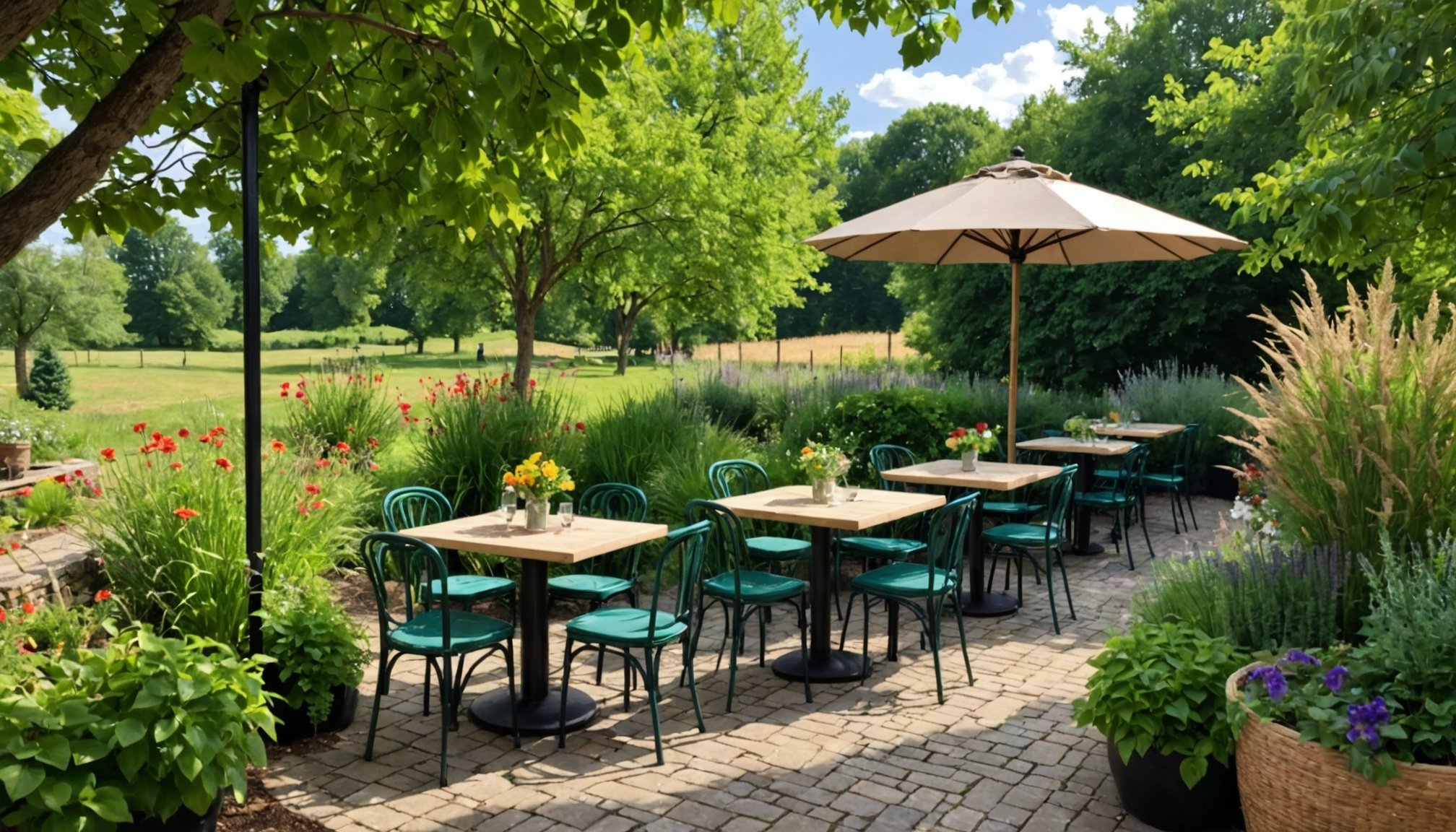Transform your rural bistro into a unique dining destination with a sensory garden that delights the senses. A harmonious blend of nature, aromas, and textures can create an unforgettable dining experience. Thoughtful design elements like fragrant plants, soothing sounds, and vibrant colors not only enhance ambiance but also stimulate conversation and connection among guests. Discover essential tips that will inspire you to craft a captivating atmosphere that keeps customers returning for more.
Essential Design Tips for Sensory Garden Dining
Creating a sensory-rich outdoor dining space enhances the overall experience.
Also to read : Essential Safety Measures for Safely Managing Chemical Cleaning Agents in Restaurant Kitchens
Importance of Sensory Elements
Incorporating sensory elements is crucial in transforming an outdoor dining space into a memorable experience. Consider the gentle rustle of leaves, the scent of blooming flowers, and the visual appeal of vibrant colors. These elements work together to engage the senses, creating a relaxing and immersive atmosphere. To achieve this, strategically place fragrant plants like lavender or jasmine, and choose materials that complement the natural setting.
Creating a Cohesive Theme
A cohesive theme ties the sensory experience together, ensuring that each design element contributes to the overall ambiance. Choose a theme that reflects the natural surroundings and resonates with your personal style. For example, a rustic theme might include wooden furniture and earthy tones, while a modern theme could feature sleek lines and minimalistic decor. Consistency in design fosters a harmonious and inviting outdoor dining space.
Have you seen this : Essential Considerations for Sourcing Sustainable Seafood for Your Restaurant Menu
Incorporating Multi-Functional Spaces
Multi-functional spaces offer flexibility, allowing for both dining and relaxation. Consider incorporating areas with comfortable seating for lounging, as well as tables for dining. Multi-functional spaces can adapt to various occasions, from intimate dinners to lively gatherings. This versatility enhances the sensory experience, ensuring that your outdoor dining area meets diverse needs and preferences.
- Sensory elements: Engage sight, smell, and sound
- Cohesive theme: Harmonize design elements
- Multi-functional spaces: Adapt for dining and relaxation
Key Sensory Elements to Enhance the Dining Experience
Enhancing your dining experience involves engaging multiple senses simultaneously.
Incorporating Attractive Scents
Scents play a crucial role in creating a memorable dining atmosphere. Introducing aromatic plants like lavender or jasmine can significantly elevate the sensory experience. These plants not only add a pleasant fragrance but also contribute to a calming environment. Consider planting them near seating areas to maximize their impact.
Textural Variations in Plant Selection
Textures in plant selection can add depth and interest to your garden. Incorporating a mix of smooth, rough, and soft plants engages the sense of touch and sight. For instance, combining the velvety leaves of lamb's ear with the rugged bark of certain shrubs creates a visually and tactilely stimulating environment.
Utilizing Natural Sounds for Ambiance
Sounds are another essential element that can enhance outdoor dining. The gentle rustle of leaves or the soothing sound of water can create a tranquil backdrop. Consider installing a small water feature or strategically placing wind chimes to add a layer of auditory interest.
- Scents: Lavender, Jasmine
- Textures: Smooth, Rough, Soft
- Sounds: Leaves, Water, Chimes
Incorporating these sensory elements ensures a rich and immersive dining experience, transforming your garden into a haven of relaxation and enjoyment.
Space and Layout Considerations
Optimizing your garden for a seamless dining experience.
Assessing Available Space
When planning your outdoor dining area, begin by evaluating the available space. This assessment is crucial for determining how to best utilize the area. Consider the dimensions and shape of your garden to decide on the most effective layout design. A well-thought-out plan ensures that every inch is used efficiently, enhancing the overall atmosphere.
Designing for Customer Flow
Customer flow is a vital aspect of any dining space. It involves creating clear pathways that allow guests to move comfortably and safely. When designing the layout, ensure that tables and seating arrangements do not obstruct movement. This not only improves accessibility but also enhances the dining experience by preventing congestion.
Creating Intimate Dining Areas
To foster a cozy atmosphere, incorporate intimate dining areas within your garden. These spaces can be created by using natural dividers like hedges or trellises, which offer privacy and a sense of enclosure. By thoughtfully arranging these areas, you can cater to different group sizes and occasions.
- Space Planning: Evaluate dimensions
- Layout Design: Optimize for flow
- Customer Flow: Ensure clear pathways
By focusing on these aspects, you can transform your garden into a harmonious and inviting dining oasis.
Selecting the Right Plants for Engagement
Crafting a sensory experience through thoughtful plant selection.
Choosing Plants that Engage Multiple Senses
Selecting the right plants is essential for creating an engaging outdoor dining space. Focus on plant selection that stimulates sight, smell, and touch. For instance, choose vibrant flowers that captivate the eye, aromatic herbs that delight the nose, and textured foliage that invites touch. This multi-sensory approach ensures a rich and immersive experience.
Benefits of Using Native Plants for Sustainability
Incorporating native plants into your garden design offers numerous benefits. These plants are adapted to local climates, requiring less water and maintenance. This makes them a sustainable choice for any garden. Moreover, native species often support local wildlife, enhancing biodiversity. By prioritizing native plants, you contribute to ecological balance while maintaining an attractive garden.
Planning for Seasonal Blooms to Maintain Interest
To keep your garden visually appealing year-round, plan for seasonal blooms. This involves selecting a variety of plants that flower at different times, ensuring continuous interest. A well-planned seasonal blooms strategy can transform your garden into a dynamic and ever-changing landscape.
- Plant Selection: Engage senses
- Native Plants: Sustainable choice
- Seasonal Blooms: Continuous interest
Thoughtful plant selection not only enhances sensory engagement but also promotes sustainability and year-round beauty.
Integrating Local Characteristics into the Design
Embrace local culture and nature to create a unique garden dining experience.
Reflecting Local Culture and Heritage
Incorporating local characteristics into your garden design enriches the dining experience by reflecting the area's culture and heritage. This can be achieved by integrating cultural elements such as traditional patterns or motifs in the decor. Collaborate with local artisans to add bespoke touches that tell the story of the region. These unique elements can create a sense of place and authenticity.
Using Regional Flora to Create a Sense of Place
Utilizing regional flora not only enhances the garden's aesthetic but also roots the space in its natural environment. Choose plants that are native to the area to ensure they thrive and require minimal maintenance. This approach not only supports local biodiversity but also strengthens the garden's connection to its surroundings. Regional flora can be a defining feature that brings the local landscape into your dining space.
Collaborating with Local Artisans for Unique Touches
Partnering with local craftsmen can infuse your garden with cultural elements that are both unique and meaningful. Consider incorporating handcrafted furniture, pottery, or sculptures that reflect local characteristics. This collaboration not only supports local talent but also adds a distinctive charm to your garden.
- Local Characteristics: Culture, Heritage
- Cultural Elements: Patterns, Motifs
- Regional Flora: Native, Biodiversity











